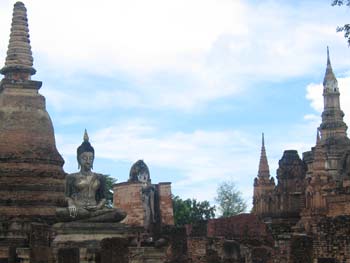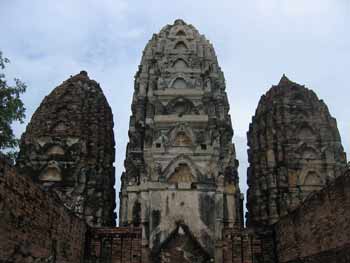Roaming the Ruins of Sukhothai
20th September, Sukhothai, Thailand
We left Phitsanulok at 9:30 this morning for a day-trip to Sukhothai, or rather Old Sukhothai, where the historical park can be found. This is the location of the first Thai kingdom, an area that boasts the remains of 21 historical sites within the old walls. Most tourists coming to Sukhothai opt to see these sites by bicycle, and we followed suit. Besides, my right hand is not improved enough for me to consider using an accellerator or hand brake just yet.
The bike rental place provided a suggested route around the various locations which we kind of followed. It was a photocopy that had obviously been run off many times before and some of the lettering was a bit difficult to read, so I opted to get a bearing on a wat, point the bike in that general direction and then see where it took us.
Even with some cloud cover, it was a very hot day for riding, but it was better to keep moving just to catch a breeze. Stopping at any of the wats to take photos reminded us that it was getting hotter the further south we got, and there was little cover from the sun at the ruined sites; they weren't big on roofing, those early Thai inhabitants.
One of the most impressive sites inside the old walls is Wat Mahathat which has some 198 chedi (tower/spires) within the monastery, along with the requisite Buddha images. There were almost too many statues and structures to take in at this spot, but I could see that this location would be perfect for a sunset photo (the silhouettes of numerous spires and statues against the impending Thai night sky).
The many spires of Wat Mahathat.
Another personal favourite is Wat Si Sawai, apparently a Khmer-style structure (it is very reminscent of the Cambodian temples of Angkor Wat and Angkor Thom, so that makes sense .. although we've yet to see those beauties for ourselves).
Wat Si Sawai, Sukhothai Historical Park
The historical park is divided into sections: the central area where most people stick to, and four other quadrants north, south, east and west where more enthusiastic cyclists can explore further (the area of the ruins covers some 7 square kilometres). We ventured out to the western section but didn't stray too far before turning back. It was obvious that there were fewer sites to see, and that they would be further apart; it was also obvious that we would be more likely to be nipped by infectious mosquitoes here than anywhere we'd been to so far. Neither Manda nor I had taken jabs for Japanese Encephalitis, we weren't taking anti-malarial pills and here was the ideal spot to make the acquaintence of a mozzie carrying one such infection (rural, in the rainy season, close to still waters such as rice paddy fields and with a nearby supply of livestock - we could tick all of these off).
By 1pm we were ready to call it a day. The hot, muggy weather was taking the energy out of us. Well, most of it - there was still one thing I wanted to check out, so I left Manda in a guesthouse's coffee lounge sat next to a rotary fan (bliss!), washed down a can of ice cold coke and then set off for one last ride. I wanted to check out Wat Sapan Hin, what looked on the photocopy map to be an impressive statue overlooking the central walled section of the historical park. A quick check with the Lonely Planet confirmed it as a 12.5 metre high statue offering a good view from a 200 metre high base, so I began the tough slog up there hopeful that the effort would be worthwhile. By the time I had clambered up the steep stone path, and probably frightened the only other two people up there with my loud hyperventilating exertions, I realised that the distance to get there should have been an indication that there would be little to see. True, there were a few chedis poking out beyond the trees in the distance, but for my money the best sight below was my waiting bike that would, with a little encouragement, take me back to the guesthouse for a bottle of ice-cold water.
We headed back towards Phitsanulok in the afternoon, eventually getting back a little after 4pm, had a while to rest before making tracks once more. While Phitsanulok didn't seem to have an awful lot to offer for the English-speaking transients, there is a night bazaar near the waterfront, and also something called the 'Flying Vegetable' that we wanted to check out (more on that soon). The night bazaar was a much smaller affair than Chiang Mai's, and was almost totally geared towards the locals. Items are cheaper here, and prices are far less negotiable. In Chiang Mai, it was possible to almost halve an asking price at the night bazaar, and walking away from a potential sale would usually result in the stall-holder following you with a new figure punched into the calculator display. Here in Phitsanulok, you'd be able to shave off 10-15% off the asking price at the most. And walking away from a sale meant just that; they would not follow you. We had noticed this already with the prices being asked by tuk-tuk drivers, they were not up for negotiation - so, we had already walked to more places than we had planned in this town!
Well, what about the flying vegetable then? At the southern end of the night bazaar we hoped to find out for ourselves, but perhaps because we were not there during the busy tourist season (and it's difficult to imagine this place full of tourists!) we were not in luck. This is what the Lonely Planet says about it: "This dish [phak bung lawy faa - a stir fried spinach dish] is nothing glorious ... but there is a performance thrown in. The cook fires up a batch of phak bung in the wok then flings it through the air to a waiting server who catches it on a plate." Tonight, though, the only thing that the servers were catching was rest.

